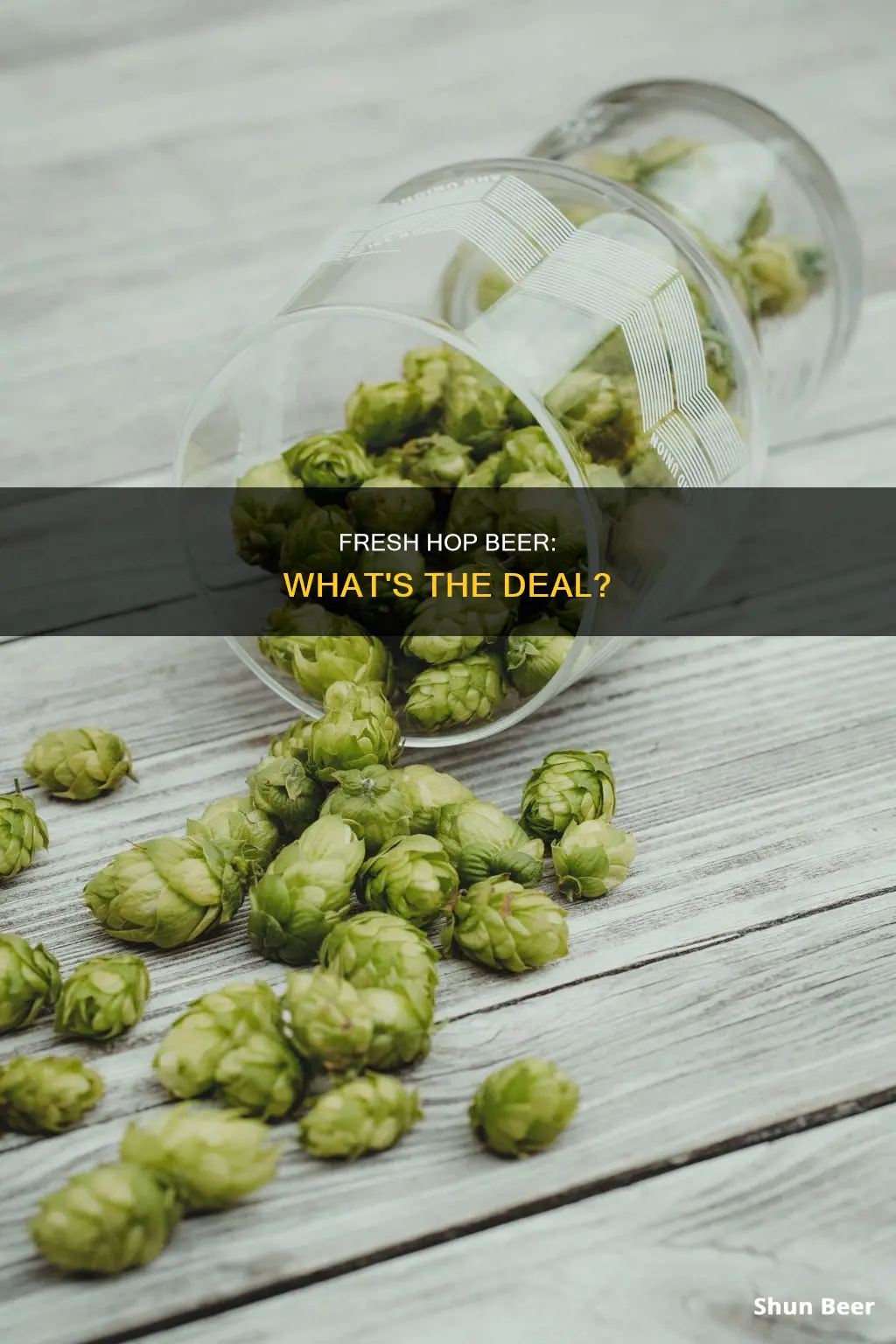
Fresh hop beer is a seasonal brew that uses freshly picked hops to provide bitterness and hoppy aromatics. These hops are used within 24-48 hours of being harvested and have a moisture content of about 80%sticky, wet, and extremely aromatic. Fresh hops are less concentrated than dried hops, so brewers need to use more of them to achieve the same level of bitterness, flavour and aroma. Fresh hop beers are typically brewed in the fall, and have a short shelf life.
What You'll Learn
- Fresh hops are sticky, wet, and extremely aromatic flowers that are freshly picked and undried
- Fresh hops have a short shelf life and expire within 24 hours of being harvested
- Fresh hop beers are usually more flavorful and hoppy than other craft beers
- Fresh hops are less concentrated than dried hops, so brewers need to use more of them to achieve the same flavour
- The best time to drink fresh hop beers is during the month of October, right after the harvests in August and September

Fresh hops are sticky, wet, and extremely aromatic flowers that are freshly picked and undried
Fresh hops, also known as wet hops, are freshly picked, undried hop flowers used for providing bitterness and hoppy aromatics to beer. They are sticky, wet, and extremely aromatic. They are picked and used for brewing within 24 to 48 hours and have a moisture content of about 80%. If they are not used within this timeframe, they start to degrade and will quickly turn into a rotten, soggy mess.
Fresh hops are heavier than dried hops, weighing nearly five times as much. This means that brewers need to use a lot more hops per batch to achieve similar levels of bitterness, flavour, and aroma. They are also less concentrated, so it takes more of them to achieve the same flavour as a beer made with dried and pelletized hops.
Fresh hops are used in a similar way to dried hops and can be added at any point in the brewing process, from the start of the boil to the whirlpool or the dry hop. However, it is recommended to use dried hops early in the boil to impart bitterness and save the wet hops for the end of the boil to get more flavour and aroma out of them.
The best time to drink fresh hop beers is during the month of October, right after the harvests in August and September. These beers have a short shelf life, although it is slightly longer than 24 hours.
Breweries that use fresh hops in their beers include Sierra Nevada, Founders Brewing Company, Bale Breaker Brewing Company, and Great Divide Brewing Company.
The Evolution of Tropical Hops in Beer
You may want to see also

Fresh hops have a short shelf life and expire within 24 hours of being harvested
Fresh hops are freshly picked, undried hop flowers used in the beer-making process to add bitterness and hoppy aromatics. They are also known as wet hops and are extremely perishable, lasting only 24 to 48 hours after being harvested before they start to degrade. This is because fresh hops have a moisture content of about 80%, making them sticky, wet, and extremely aromatic. They are prone to browning and decomposition, and if not used promptly, will turn into a rotten, soggy mess.
The short shelf life of fresh hops poses a unique challenge for brewers, as they must be used almost immediately after harvest. Brewers must analyse the moisture level of the hops to ensure they are within the optimal range for brewing. Fresh hops are less concentrated than dried hops, so brewers need to use more of them to achieve the desired flavour and aroma in their beer.
To extend the shelf life of fresh hops, some brewers kiln-dry the hops and use them as whole cones during the brewing process. These dried hops can be stored and used throughout the year, although they may lose some of their unique flavour and aromatic qualities.
The use of fresh hops in beer-making is seasonal and typically occurs during the hop harvest season from late August to September. Brewers must work quickly to process the hops and create their fresh hop beers, which also have a short shelf life. The best time to drink these beers is during the month of October, right after the harvest.
The ephemeral nature of fresh hops and fresh hop beers makes them a unique and exciting experience for beer enthusiasts. Those who want to savour the flavour of fresh hops should seek out breweries close to the source, as the ingredients are at their best when fresh and locally sourced.
Budweiser's Hoppy Taste: Beer Style Secrets Revealed
You may want to see also

Fresh hop beers are usually more flavorful and hoppy than other craft beers
Hops are typically dried to preserve their aromatic qualities and volatile oils, but this drying process causes the most volatile oils to dissipate. Fresh hops, on the other hand, have completely intact hop oils, resulting in more resinous and pungent flavors.
Fresh hops also impart unique flavor profiles to beer. While you can still expect the typical varietal-specific flavors, such as citrus, floral, or tropical fruit, fresh hops also contribute a delightful grassiness. Chlorophyll flavors, like freshly cut grass, spiciness, and tobacco, are all part of the fresh hop experience.
In addition, fresh hops are less concentrated, so it takes more of them to achieve the same level of bitterness, flavor, and aroma as dried hops. This results in fresh hop beers having a stronger hoppy character.
The process of brewing with fresh hops is more challenging for brewers, as it requires coordination between the hop grower and brewer, with harvest, delivery, and brewing all taking place within a 24-hour period. Despite this, fresh hop beers have become a sensation among craft beer lovers, with many breweries now growing their own hops on-site to bypass the logistical challenges of obtaining fresh hops.
The Hoppiest Beers: Exploring the Bitterness and Aroma
You may want to see also

Fresh hops are less concentrated than dried hops, so brewers need to use more of them to achieve the same flavour
Fresh hops are also known as "wet hops". They are freshly picked, undried hop flowers used to impart bitterness and hoppy aromatics to beer. They are highly perishable and need to be used within 24 to 48 hours of harvesting. Due to their high moisture content, fresh hops are less concentrated than dried hops, and therefore brewers need to use a lot more of them to achieve the same level of bitterness, flavour, and aroma in their beer. For example, if a brewer would normally use one ounce of dried hops to achieve a certain level of bitterness, they would need to use five to eight ounces of fresh hops to achieve the same result.
Fresh hops are typically used in the same way as dried hops, and can be added at any point in the brewing process, from the start of the boil to the whirlpool or dry hop phase. However, it is recommended to use dried hops early in the boil to impart bitterness, as this allows for more accurate prediction of bitterness levels, and saves the fresh hops for later flavour additions.
Fresh hops impart a unique flavour profile to beer compared to dried hops. While you can still expect the typical varietal-specific flavours, such as citrus, floral, or tropical fruit, fresh hops also contribute a delightful grassiness. Chlorophyll flavours, like freshly cut grass, spiciness, and tobacco, are all part of the fresh hop experience. These flavours can be accentuated by using fresh hops in an IPA or a traditional English ale.
In addition to their impact on flavour and aroma, fresh hops also present some technical challenges for brewers. Since fresh hops have a high moisture content, they weigh significantly more than dried hops. This means that brewers need to use larger mesh bags or other special equipment to accommodate the increased volume of hops during the brewing process. Furthermore, sanitising fresh hops can be difficult, especially when used in cold-side processes such as dry-hopping, as they are prone to moulding and oxidation.
Despite the challenges, brewing with fresh hops offers a unique opportunity to showcase the summer's bounty and gain insight into the raw materials used in beer-making. It provides a direct connection with the hop plant, allowing brewers to experiment with freshly picked ingredients and create exciting and delicious brews.
Starting a Beer Hop Farm: A Beginner's Guide
You may want to see also

The best time to drink fresh hop beers is during the month of October, right after the harvests in August and September
Fresh hop beers are seasonal brews that are made with an ingredient that has a very limited availability. These beers are brewed with whole hop cones that are used straight from the bine, rather than the dried pellets that are more commonly used in beer. Fresh hop beers are brewed during and shortly after the hop harvest season, which typically takes place from late August through September.
Fresh hops are extremely time-sensitive. They need to be used within 24 to 48 hours of being harvested, as they start to degrade very quickly. This means that fresh hop beers are brewed within a day or two of the hops being picked. They also have a short shelf life, although this is longer than 24 hours. So, the best time to drink fresh hop beers is during the month of October, right after the hops have been harvested in August and September.
Fresh hop beers are known for their floral, piney, and grassy flavours and aromas. They are usually made into a pale ale or IPA, although other styles are also made. These beers are highly anticipated by beer enthusiasts, as they can only be enjoyed once a year and are very different from beers brewed with dried hops.
If you want to have the best experience drinking fresh hop beers, it's recommended that you drink them close to the source, as they taste best when they are fresh. Washington and Oregon are the top two hop-producing states in the US, so you're likely to find many breweries in these states that offer fresh hop beers and host festivals celebrating this seasonal brew.
Hops in Beer: Understanding the Magic Numbers
You may want to see also
Frequently asked questions
Fresh hop beers are brewed with hops that are fresh off the vine, or "bine", and have not been dried or processed. They are brewed within 24 hours of being picked.
Fresh hop beers are known for their floral, piney, grassy, and earthy flavours. They are less bitter than beers made with dried hops.
Fresh hop beers are brewed during the short harvest season, typically from late August to September.
Fresh hop beers are usually brewed near hop farms, as the hops need to be used within 24 hours of being picked. In the US, many breweries in Washington and Oregon offer fresh hop beers and host festivals celebrating the seasonal brew.







